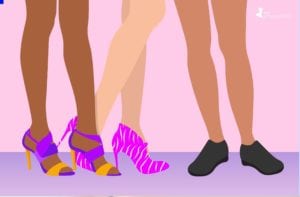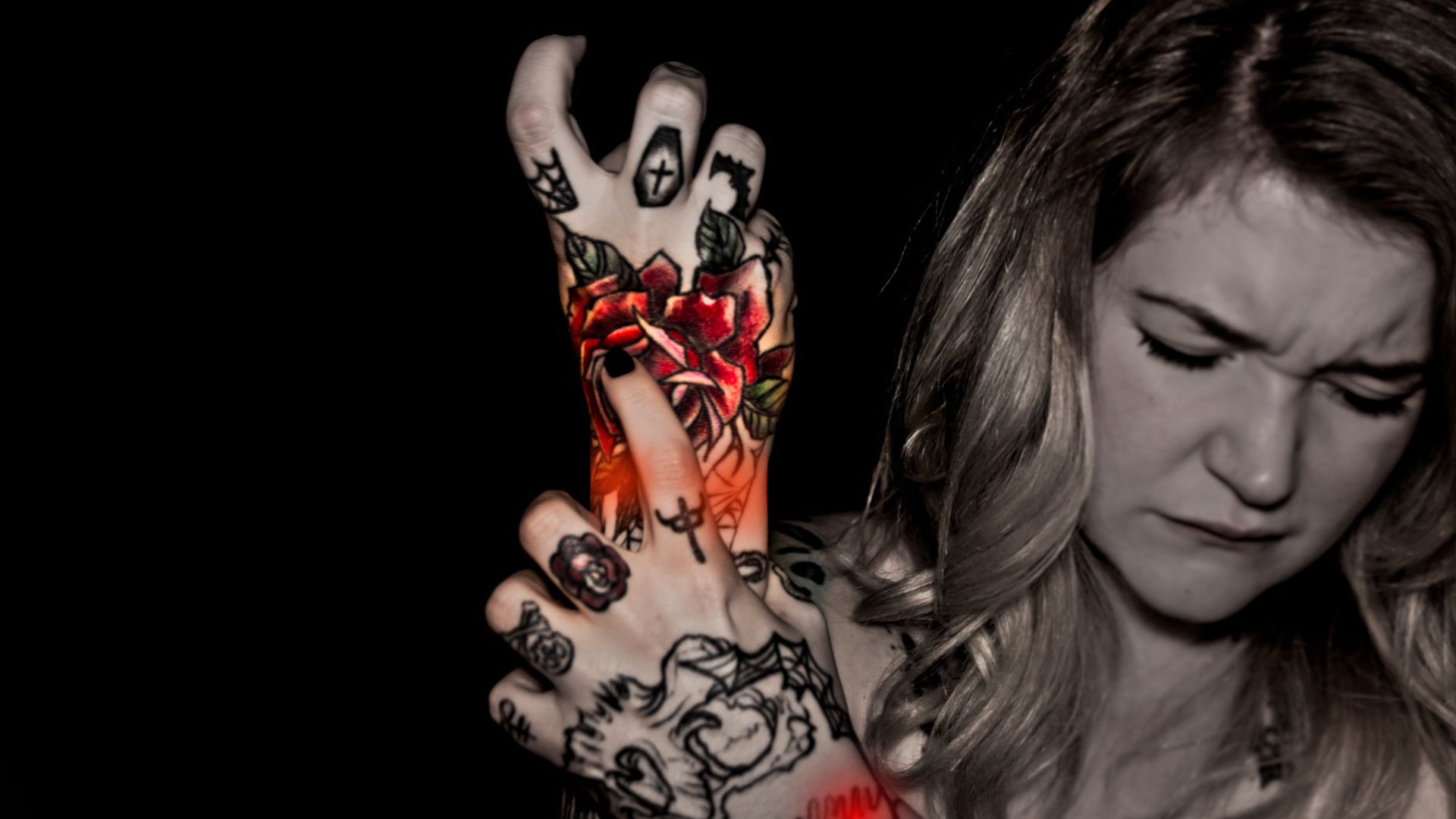I’ve always had big feet. They seemed to grow faster than the rest of me — and are now around a ladies size 11.5 (43 Eur) as well as super-wide.
As a child, I had a slightly awkward walk and knock knees. It wasn’t until I was an adult that I learned that my left leg is 20 mm (just under 0.8 inches) shorter than my right. It’s not enough to be really noticeable to others, but it is enough to have caused some curvature in my spine.
To help reduce pain and too much further damage, I now wear bulky orthotics in athletic shoes most of the time. The left orthotic is built up higher than the right, so buying shoes is even more of a challenge for me these days.
Before developing rheumatoid arthritis in my hands and feet more than 10 years ago, I could still get away without wearing the orthotics every so often. I could wear low heels when going out or flat open sandals on hot days.
Cut to today: I have also been diagnosed with ankylosing spondylitis in my sacroiliac joints and spinal stenosis in my lumbar spine. Medications and core strength exercises help me manage these conditions, but if my feet aren’t comfy, the rest of me can get very achy and tired very quickly.
That’s why, when it comes to choosing outfits, it’s all about the shoes.
Why One Shoe Doesn’t Fit All
Because of my arthritis and other health conditions, I can no longer work in a 9-to-5 job, but I do work a bit from home. One advantage of that is I don’t have to conform to any dress code. I can wear loose, comfortable clothes (or even my pajamas) when I work. But when I leave the house, things are different.
I know some people can get away with wearing closed shoes or boots with skirts and dresses, but when I do that, I’m really self-conscious of my massive feet. Don’t get me wrong, I like my feet and appreciate the work they do. I just feel they look out of proportion to the rest of me.
Other people can find nice, supportive shoes in smaller sizes or can choose to wear dressier shoes and put up with the pain for a while.
I don’t have those options.
Most of the shoe styles I like don’t come in my size and I cannot compromise on comfort. Any pain my shoes cause me flows from my toes up through my legs and back and is just not worth it.
Most of the time, I can still wear my trusty black leather lace-up sneakers. (I love New Balance shoes as they come in wide fittings.) I can wear these with casual clothes like jeans and shorts. Occasionally, I can wear a pair of men’s plain black leather business shoes. However, they still have to be lace-ups to accommodate fluctuating levels of inflammation and swelling in my feet. Plus, they need to have some shock absorption in their soles and good support around the back of the heel without being too heavy.
I can even wear supportive sandals with Velcro straps for a trip to the pool or somewhere where I don’t have to stand or walk for more than a few minutes. But if I’m going somewhere where I need to dress up a bit more, I don’t have great shoe options.
Style vs. Comfort: The Great Debate
When I have a dressier occasion to attend, here’s my dilemma: Do I find a nice outfit and then attempt to find shoes that not only fit but also look nice and are not too painful to wear? Or do I stick with one of my trusty blacks and somehow avoid them looking as conspicuous as a pair of Ronald McDonald’s shoes?
Honestly, I usually go with option B. I wear some loose long black pants that (mostly) cover them. However, I make sure that I wear a pretty blouse with nice jewelry and makeup to balance out the blandness of the rest of my outfit.
I’ve also found a pair of Homyped sandals (a popular Australian comfort shoe brand) with a touch of bling on them that I can use when I wear a skirt or dress on more formal occasions. I still feel underdressed when I’ve got them on and all the other ladies are in high heels, though.
Shoe Shopping with Arthritis: How It Affects Your Mood and Self-Esteem
Before writing this article, I did an online search to find if other people with arthritis had experienced similar shoe shopping challenges. I’ve come across the topic discussed many times in online support groups, but I struggled to find articles on the subject.
CreakyJoints has published many great pieces on looking after your feet and buying shoes when you have arthritis, but I wanted to know how others feel when they need to buy shoes.
Then I found it — the holy grail of research on how arthritis affects your shoe choices — and, therefore, your overall appearance: A 2010 study titled, “‘If I Didn’t Have RA, I Wouldn’t Give Them House Room’: The Relationship Between RA, Footwear, and Clothing Choices.” Researchers interviewed 15 women with rheumatoid arthritis in order to develop a greater understanding of the impact of RA on women’s self-image and self-presentation via an exploration of their clothing choices. Their observations proved to me that I’m not alone in feeling so limited when shoe shopping. Here’s some of what the study participants said about selecting shoes with arthritis:
“All trousers now, I used to love skirts but don’t now anymore, trousers. I never ever wear skirts now.”
“I tend to go for the summer sandals and hope it’s not too cold. I have got a pair of black shoes I can wear. But I don’t wear them very often, I just don’t feel, it’s only a little heel but I don’t feel comfortable in them. No, I tend to go for my summer sandals and hope that it’s not a freezing cold night, you’d look totally silly”
“It’s hard to get a comfortable pair of shoes; you don’t want to wear horrible shoes when you’re wearing a nice skirt, so therefore you can’t wear [skirts] because all the shoes are real horrible.”
As I read through the women’s comments in the report, I felt as though I could have written them myself. These women were part of my tribe. I know there will be many others out there (of all genders) who will feel part of this tribe, too.
“All the women had found shoes that met the requirements of middle-ground outfits which tend to be comfortable and serviceable,” the authors wrote. “However, when required to dress outside of this middle ground all experienced shoe-related problems that either excluded them from looks they connected with femininity, elegance, or professionalism.” They concluded, “this left them feeling excluded, self-conscious and vulnerable to the critical gaze of others.”
The authors also noted that women with RA have lower levels of self-esteem and worse body image than those without RA. While joint damage and disfigurement of course plays a role, “the subtle ways in which women’s limited choice of shoe constrained their self-presentation and clothing choices in this study may offer some insights into factors, other than disfigurement, that contribute to such dissatisfaction,” the authors wrote.
What We’d Like People Without Arthritis to Know About Shoes
My first plea goes out to footwear makers. We need more comfortable, supportive, and flat shoes in designs that suit many different fashion preferences and lifestyles. Please make shoes like this more affordable and available in a greater range of sizes.
To the wider community, please avoid judging us if our shoes or clothes are more comfy than classy. People with arthritis might look “normal,” but you have no idea how much pain we are in or how much energy it takes for us to even try and look presentable.
Finally, to my arthritis tribe. Do whatever you need to do to look after your feet and keep them as comfortable as possible without worrying about what other people think. Think footloose and fancy-free!
Keep Reading
Goodacre LJ. ‘If I didn’t have RA I wouldn’t give them house room’: the relationship between RA, footwear and clothing choices. Rheumatology. 2010. doi: https://doi.org/10.1093/rheumatology/keq347.






